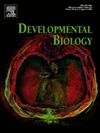斑胸草雀卵母细胞中含卷曲素的核生物分子凝聚物。
IF 2.5
3区 生物学
Q2 DEVELOPMENTAL BIOLOGY
引用次数: 0
摘要
在大多数动物中,卵母细胞生长伴随着基因组激活、核体积增加以及通过涉及内在无序蛋白区(IDRs)和相分离的多价相互作用形成各种生物分子凝聚物(BioMCs)。在这项研究中,我们描述了在基因组学和神经生物学的模式物种斑胸草雀(Taeniopygia guttata, Passeriformes, Aves)的卵母细胞中通过光学显微镜检测到的特定核生物分子凝聚物(NBioMCs)。我们在早期二倍体阶段的卵母细胞中发现了一个核仁,并观察到许多NBioMCs在灯刷阶段(一个活跃转录时期)的卵母细胞中检测出卷曲蛋白阳性。coilin阳性的NBioMCs可自由分布于细胞核内或与染色体着丝粒相关。它们与几种已知的核结构具有相同的特征,包括核仁(由于纤维蛋白和核仁蛋白的存在)、Cajal小体(以coilin和scaRNA2为标志)、染色质间颗粒团簇(含有SRSF2)和在其他鸟类物种中描述的着丝粒蛋白小体(当染色体相关并含有STAG2和SMC5时表现出着丝粒定位)。然而,它们在斑胸草雀卵母细胞中的具体功能尚不清楚,需要进一步研究。本文章由计算机程序翻译,如有差异,请以英文原文为准。
Coilin-containing nuclear biomolecular condensates in zebra finch Taeniopygia guttata growing oocytes
In most animals, oocyte growth is accompanied by genome activation, an increase in nuclear volume, and the formation of various biomolecular condensates (BioMCs) through multivalent interactions involving intrinsically disordered protein regions (IDRs) and phase separation. In this study, we characterize specific nuclear biomolecular condensates (NBioMCs) detectable by light microscopy in the oocytes of the zebra finch (Taeniopygia guttata, Passeriformes, Aves), a model species in genomics and neurobiology. We identified a nucleolus in oocytes at the early diplotene stage and observed numerous NBioMCs that tested positive for coilin in oocytes at the lampbrush stage, a period of active transcription. The coilin-positive NBioMCs may be freely distributed within the nucleus or associated with chromosome centromeres. They share characteristics with several known nuclear structures, including nucleoli (due to the presence of fibrillarin and nucleolin), Cajal bodies (marked by coilin and scaRNA2), interchromatin granule clusters (containing SRSF2), and centromeric protein bodies (CPBs) described in other avian species (exhibiting centromeric localization when chromosome-associated and containing STAG2 and SMC5). However, their specific function in zebra finch oocytes remains unclear and requires further investigation.
求助全文
通过发布文献求助,成功后即可免费获取论文全文。
去求助
来源期刊

Developmental biology
生物-发育生物学
CiteScore
5.30
自引率
3.70%
发文量
182
审稿时长
1.5 months
期刊介绍:
Developmental Biology (DB) publishes original research on mechanisms of development, differentiation, and growth in animals and plants at the molecular, cellular, genetic and evolutionary levels. Areas of particular emphasis include transcriptional control mechanisms, embryonic patterning, cell-cell interactions, growth factors and signal transduction, and regulatory hierarchies in developing plants and animals.
 求助内容:
求助内容: 应助结果提醒方式:
应助结果提醒方式:


